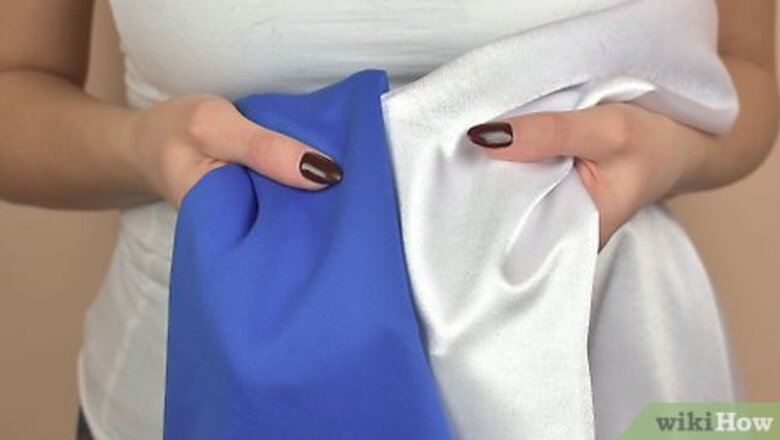
views
Finding the Right Fabric

Pick a color. Typically, adult Roman males wore an off-white color for their togas. The color was that of the un-dyed fabric. However, other colors were worn, though they typically denoted something specific about the person wearing them. For instance, if the toga was truly white because the fabric was bleached, that generally indicated the person was in public office. Dark colors indicated the person was in mourning. White with a purple border was worn by curule magistrates, while purple with a gold thread around the border was worn, at different times, by generals (although only those who had won battles and wars), kings, and emperors.
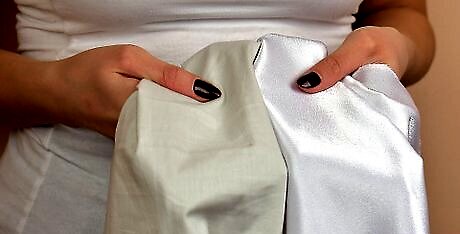
Choose a type of fabric. The Romans wore wool, mainly because it stayed in place better than other fabrics. However, wool can be itchy, as well as very warm. In addition, wool is an expensive fabric. If you want something cheaper, a cotton blend should be fine. Muslin is a good option, because it is light and flowing. Another option is any flannel that is flowing. You can find both of these fabrics at your local fabric store. Basically, you don't want anything too smooth because it will slip right off.
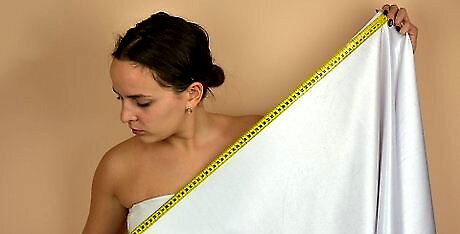
Get the right length. A true toga requires about 4 to 5 yards (4 to 5 m) of fabric, depending on your height and build. If you're a bit larger, you may want to spring for 6 yards (5.5 m), just in case. At the fabric store, you can specify how much fabric you want. Sometimes, if you get the end of a bolt, the store will give you a discount on buying the rest of the bolt passed what you ordered to be cut. For instance, if you ask for 4 yards and the bolt has 4 3/4 yards, the store may give you a discount if you want that extra 3/4 of a yard.

Go for a sheet. Another, easier option is to use a simple bed sheet. While you don't get as much length as a traditional toga, it can be a simple way to create a toga. A queen is a good size. It's slightly longer than a full, but it doesn't have as much width as a king. Some people prefer a twin or full because it doesn't add as much bulk.

Wash the fabric. It can help to wash and dry the fabric. Washing it makes it softer, which can help it flow better. Try adding a fabric softener to help with the process. You can run it through the washing machine twice if once doesn't soften it up enough to drape well.
Sewing the Toga
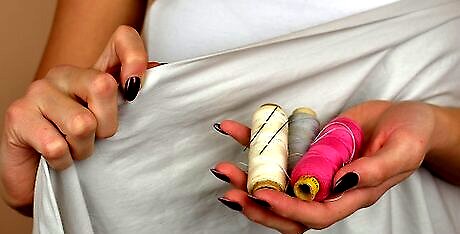
Decide if and how you want to sew your fabric. You can use the fabric just as it is. However, you can also sew it to make a toga that is more in line with a traditional shape. Another option is to simply hem the edges. While it won't matter with some fabrics, hemming the edges will keep your toga from fraying. If you don't care about fraying, you can skip the hemming process.
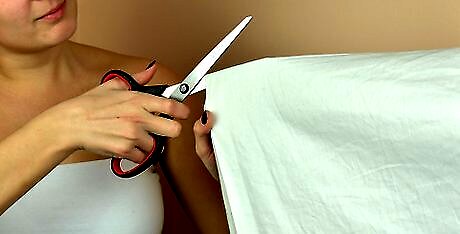
Cut the toga. The shape of the toga changed over the years. You can cut your toga to be more like a traditional toga, if you want. However, you can simply leave it as a rectangle, as well, which is how you will get it from the store. One shape was a straight line across the top and a curve across the bottom, creating pointed ends. A later shape was more of a hexagon, with a straight line across the top, with two lines slanting down to points. The bottom was a straight line with two lines slanting up to the same points, though these are slightly curved. This shape is flatter than an regular hexagon. If you want either of these shapes, cut the fabric with fabric scissors, leaving about 2 ⁄4 inches (5.7 cm) around the sides to hem the fabric.
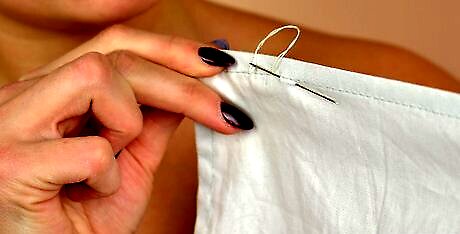
Hem the edges. Whether you are hemming the edges of the rectangle or of the toga you cut out, you can use a simple double-folded hem. If you have any curved edges, you might need to take one extra step of sewing along it before folding. Iron the edge. To hem the raw edges, fold the fabric in about ⁄4 inch (1.9 cm). If you're hemming a curved edge, you can make this part easier by sewing along the edge first, about 3/4 of an inch in, then fold it along that line. Iron the edge. Fold it in again, this time about 1 1/2 of an inch in. Iron it again. Sew along the inside edge. To tack the hem down, sew it down, closer to the inside edge than the outside edge. You can also sew small weights into the hem to help it hang better.

Use fabric adhesive. If you prefer not to sew, you can use fabric adhesive. Iron the hem first, folding it over twice like you would if you were sewing. Then either use a liquid adhesive or an iron-hem tape to glue it down. If you use the hem tape, you'll probably need to iron the outside of the fabric to make it stick. Make sure to not make the glue too thick, or it can show through the other side. Test it first to see how it looks.
Draping the Toga
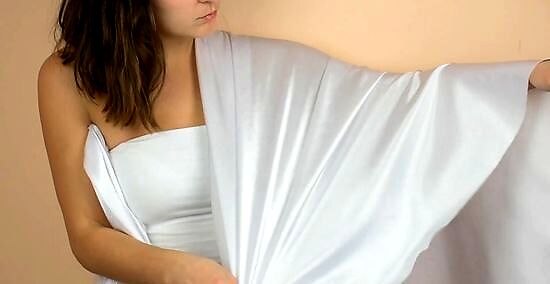
Start with your left arm. Take one corner or edge, and fold it over your left arm from the back. It should hang down pretty far, past your knee. If you used the hexagon shape, you'll need to fold it in half first. The Romans usually wore at least a tunic underneath their togas. You can wear a shirt and shorts/pants or a skirt to help cover up.
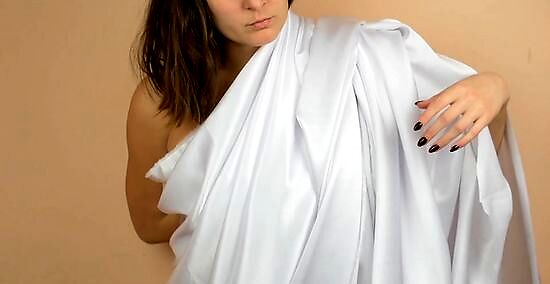
Drape the other part around your back. Pull the rest of the fabric around your back. The part that drapes around the top of your shoulder/arm should also be on top when it comes around your back. In other words, you don't want it to twist. Pull it around so that it comes around your right side, underneath your arm. You might need some help at this stage, since the fabric is so long.

Wrap it across the front of your body. Pull the fabric around the front of your body, leaving enough to drape down your right side. Throw the rest of the fabric over your shoulder. Make sure the fabric drapes around your hip. You don't want it to be too tight. Also, this step makes the length of your toga, so make sure it is long enough. The next step will partly cover your torso.
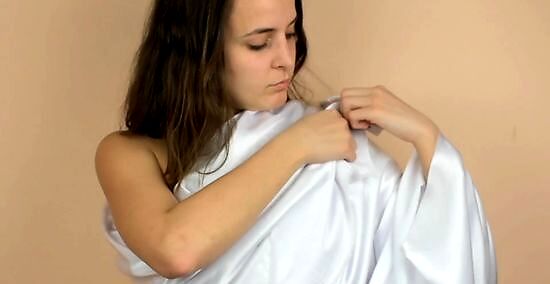
Wrap it around again. Come around your right side a second time, again under your right arm. Let it drape down your right side, a little higher than the first time. Throw the end over your shoulder again. The point should be a bit higher in back than it is in front.
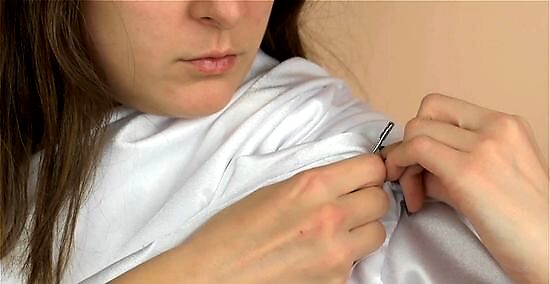
Adjust the toga. Look in the mirror, and adjust the drape. You may need to pull it in places so it covers more. Lengthen or shorten the ends as needed. You can also pin it to help in stay in place. A good place to pin it is on the left shoulder. Though the Romans usually didn't pin their togas, pinning it will give you more freedom to move, as the toga was fairly restrictive. You can also use a belt to help hold it in place.

Accessorize your toga. You can use plastic swords and shields that can be purchased at a dollar store, toy store, or costume store. You may also look for fake gold chains, jewelry, or amulets to accessorize your toga. Wear sandals to complete the look. Another option is to create a fake laurel wreath. Unfurl a wire coat hanger, and reshape it into a wreath around your head. Get plastic leaves from an art supply store or gather real leaves and glue them or wrap around the wire. Make sure you let the glue dry. Be liberal when applying the leaves to cover the wire.
Creating a Toga From a Sheet
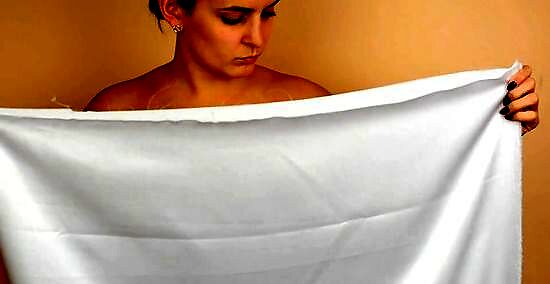
Fold the sheet. How far you fold it depends on your preference. Nonetheless, it should be folded approximately in half lengthwise. If you use a twin or a full sheet, you don't need to fold the toga. If you fold it exactly in half, you will make a very short toga. For a longer toga, don't go all the way down when folding it. Just fold it partway. Remember, togas were generally worn over tunics, so you can wear it over a shirt or some other type of garment or even your regular clothes. Using a sheet, in particular, creates a fairly skimpy toga, so you probably want to wear something under it.

Drape one end over the left arm. You can drape the whole edge over the left arm. This end will hang down in front. Another option is just draping the the top corner over so it forms a point. If you're draping the toga yourself, the easiest way to do this step is to throw the whole sheet over your shoulders like a cape, lengthwise. On your left side, pull it so just the end is hanging over your arm, then pull up the slack on the other side.
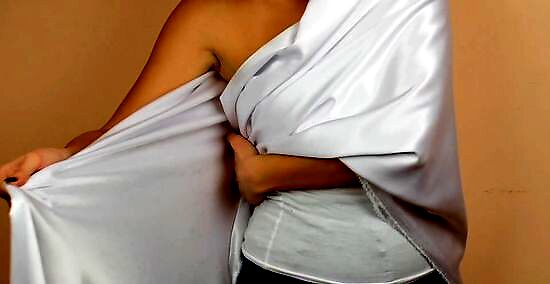
Pull it under your right arm. Now that you've got it draped on the left side, pull it under your right arm. You can leave it over your right arm, as the Romans sometimes wore togas almost like a sling, but you'll have more movement if you pull it under. Try to gently pleat the part that goes under your arm. That is, when it comes around your hip from the back, use your hands to fold the fabric back and forth, so it drapes in small folds.
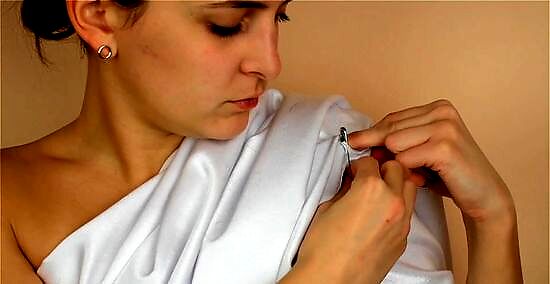
Throw the rest over your shoulder. Finally, take the end and push it over your left shoulder. Try to get as much of it over your shoulder, while still pulling the right side down over your hip somewhat. Though the Romans didn't usually pin their togas, you can use a safety pin to pin it at the shoulder. That way, it won't slip off.




















Comments
0 comment